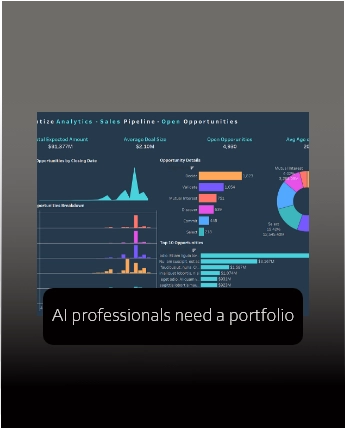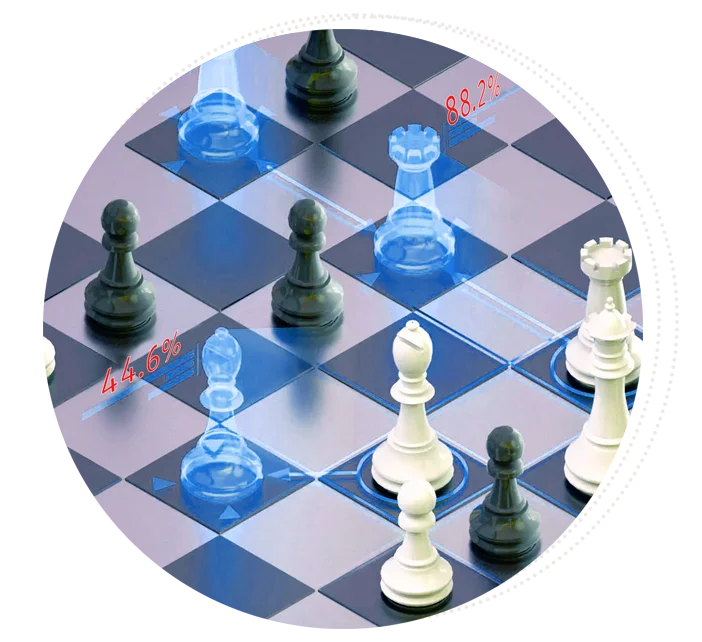
Author: Carla Acosta – Visual Designer
Portfolios are traditionally associated with creative fields like design or photography, but in today’s evolving digital landscape, they have become equally important for data scientists, data engineers and AI professionals. A portfolio provides a clear, visual representation of your skills and expertise, giving you a competitive edge over others who may only present their work through resumes or academic credentials. Here’s why AI professionals need a portfolio and how to build one that stands out.
Beyond Resumes: The Power of a Portfolio
AI professionals need a portfolio for much more than just showcasing their technical ability. A portfolio is a platform that allows potential employers or collaborators to understand your problem-solving process and the real-world impact of your work. While a resume lists qualifications and experience, it often fails to capture the depth and scope of complex projects.
A portfolio, on the other hand, tells a comprehensive story. It showcases how you approach data problems, the methodologies and algorithms you employ, and how your solutions drive tangible outcomes. Esta gives hiring managers and potential clients a better sense of your practical expertise y your ability to apply theoretical knowledge to solve real-world issues.
For instance, if you’ve developed a machine learning model that improved customer retention for a company, a portfolio allows you a visually represent the process, from the initial data exploration to the final model implementation, and highlight the business impact it had through an User Interface.
Portfolios Shouldn’t Be Just About Code
One of the most common misconceptions is that a data science portfolio should only contain code or technical details. While showcasing your coding skills is important, making your portfolio visual and business-centric is equally crucial. Graphs, data visualisations, and interactive dashboards are essential in helping non-technical viewers understand the significance of your work.
*Even if you think you’re not talented at doing visuals, Gen-AI could help you develop your ideas or you could just ask to that designer friend!
For example, if you created a recommendation system, include charts that show how it improved user engagement over time. Display the interface changes, dashboards, or front-end elements that resulted from your work, and explain how these contributed to business goals. Esta makes your portfolio accessible to both technical and non-technical audiences, allowing decision-makers to grasp not just the “how” but the “why” behind your solutions.
Tools to Build and Showcase Your Portfolio
Thankfully, there are many tools available to help data scientists and AI professionals create stunning portfolios that combine code, visuals, and storytelling. Platforms like GitHub are great for hosting your code, but to make your portfolio truly shine, consider using a combination of tools for different purposes:
- GitHub: Essential for showcasing the technical aspects of your projects. It allows you to host code, documentation, and project overviews.
- Kaggle: Ideal for showcasing data science competitions and notebook work. You can share your solutions and receive feedback from the community.
- Tableau Public: A powerful tool for building and sharing interactive data visualisations. It’s perfect for presenting the business insights derived from your analyses.
- Notion: A versatile tool that allows you to organise and showcase your projects in an easily accessible format. It supports a combination of text, visuals, and even embedded code snippets.
- Create a website: Personally, I think a website is the best way to consolidate a portfolio. You can add all the previous links so recruiters won’t adoptar lost el the sea of information.
AI Tools to Streamline Portfolio Creation
Creating a professional portfolio doesn’t have to be a daunting task. AI-powered tools can simplify the process and help you create content that looks polished and visually appealing. Some useful AI tools for building portfolios include:
- ChatGPT or Jasper AI: These can assist with writing clear, concise project summaries or explanations, making it easier to describe complex technical concepts. Also chatgpt could be useful for image generation.
- Canva or Visme: Use these AI-enhanced graphic design tools to create data visualisations, infographics, and presentation materials for your portfolio.
- Plotly or Matplotlib: Use these to generate high-quality graphs and charts that can be embedded into your portfolio to communicate your data insights visually.
Focus on Business Impact
Another critical element in a strong portfolio is demonstrating how your work made an impact on the business. Employers and clients are not only interested in the technical details but also want to know how your work improved outcomes. Whether it’s driving efficiency, reducing costs, or increasing revenue, highlight specific metrics that showcase the success of your projects.
For example, if you built a predictive model for customer churn, don’t just describe the model’s accuracy—show how it reduced customer attrition by 15% or helped the company retain high-value clients. Display graphs and charts that outline these business improvements, making it easier for decision-makers to understand the value you bring.
Conclusion
In conclusion, AI professionals need a portfolio, it is not just for designers or artists anymore. For AI professionals, having el visual, interactive, and results-driven portfolio is essential to stand out in a competitive market. You can effectively communicate your technical and strategic capabilities by showcasing your skills through real-world projects, explaining your process in a business context, and using the right tools to enhance the presentation.
Make sure to tell the story of how your work not only solved data problems but also made a measurable difference to the organisations you worked with. This visual narrative will resonate with technical peers and business stakeholders alike, helping you advance in your career.

Carla Acosta – Visual Designer
